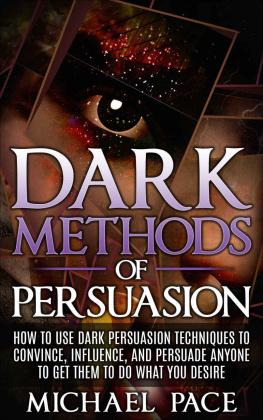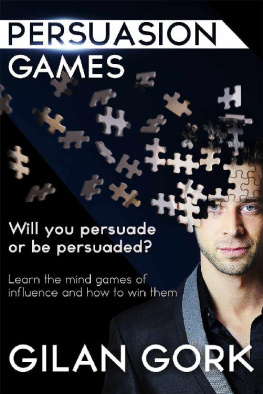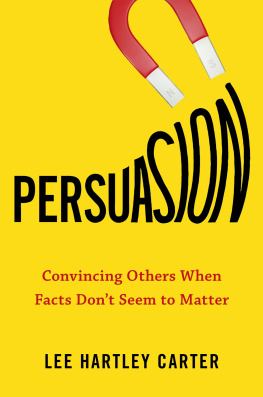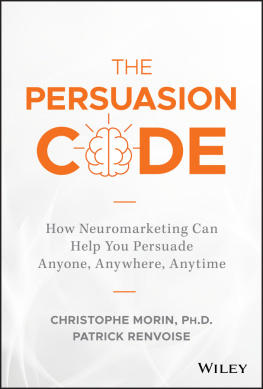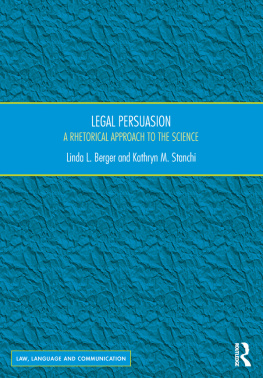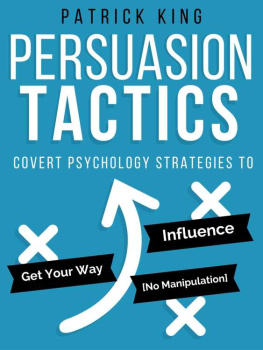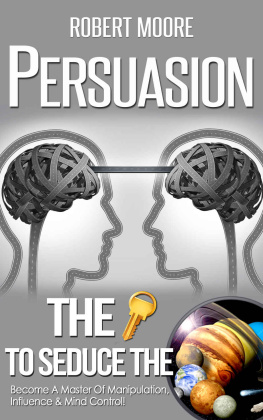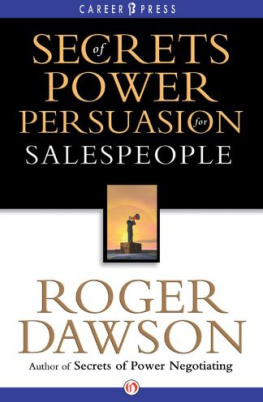Advance praise for 7 Secrets of Persuasion
"7 Secrets of Persuasion is accessible, smart, and important. Jim Crimmins has distilled his years of experience as a professional persuader and advertiser into a book on how to develop compelling and persuasive messages...it is well worth our attention."
Ellen Wartella, chair, Department of Communication Studies, Northwestern University and Professor of Psychology
This is great stuff. Your clear and concise translation of these principles is something every public health communicator should be exposed to.
Matthew Kreuter,
Kahn Family Professor of Public Health, Associate Dean for Public Health, senior scientist, Health Communication Research Laboratory,
Washington University in St. Louis
7 SECRETS OF PERSUASION
Leading-Edge Neuromarketing Techniques to Influence Anyone
By James C. Crimmins, PhD

Copyright 2016 by James C. Crimmins, PhD
All rights reserved under the Pan-American and International Copyright Conventions. This book may not be reproduced, in whole or in part, in any form or by any means electronic or mechanical, including photocopying, recording, or by any information storage and retrieval system now known or hereafter invented, without written permission from the publisher, The Career Press.
7 SECRETS OF PERSUASION
EDITED BY ROGER SHEETY
TYPESET BY DIANA GHAZZAWI
Cover design by Howard Grossman/12E Design
Printed in the U.S.A.
To order this title, please call toll-free 1-800-CAREER-1 (NJ and Canada: 201848-0310) to order using VISA or MasterCard, or for further information on books from Career Press.

The Career Press, Inc.
12 Parish Drive
Wayne, NJ 07470
www.careerpress.com
Library of Congress Cataloging-in-Publication Data
CIP Data Available Upon Request.
For Rita
CONTENTS
FOREWORD
Anyone who wishes to persuade a child, a boss, a partner, a spouse, or a customer in a showroom should read this book. The principles of persuasion Jim Crimmins reveals on the pages that follow apply in any situation where individuals need to be persuaded to do something they are not doing or, conversely, to be persuaded not to do something they are already doing.
As a longtime practitioner of advertising, I wish Jim had written this book years ago when I was still working day to day in the business of creating campaigns for clients and trying to get them to understand what we intuitively knew: Consumers may rationalize a brand choice, but the choice is really driven by their emotions. People dont choose a brand based on facts and rational arguments any more than they choose a life partner or a political candidate that way. Instead, they base their purchase decisions pretty much on their feelings about a brand, feelings created in large part by the brands advertising. Thats why, as Jim so convincingly points out in this book, asking people why they do things is not only a mistake, it will take you down the wrong path. It turns out that people actually dont know why they do certain things; so, in trying to tell you, theyll misguide you. Instead of asking them, Jim urges us to unearth peoples true motivations, and he shares some proven ways to do that.
Its a shame that we in advertising, when I was still involved in the work every day and even now, have never been able to fully explain how our product works, how advertising can attach real values and set expectations that actually transform the experience of using a brand. Nor have we always been able to prove that the most persuasive advertising may present no rational argument at all. Its sad to think about so many potentially great campaigns rejected by clients who, in the absence of the kind of scientific evidence contained in this book, were conned by copy testers with bogus systems into believing that the measure of success for advertising was a respondents ability to recall copy points or play back a brands so-called unique selling proposition. We have always felt passionately that real persuasion is more about a unique selling personalityhow a brand looks and feels and acts, what a brand does rather than what it says, indeed what a brands body language conveys. But we have always been at a loss to prove such a point of view and so some of the very best ideas have gone down in flames.
Thats because until now, we werent armed with the groundbreaking discoveries made by the new science of the mind detailed in this book. Within these pages, Jim details dozens of recent scientific studies that prove in various ways how and why a reasoned argument can be a waste of time and why, to be successful as persuaders, we must get to know the lizard, which is Jims way of describing the brains automatic, nonconscious mental system that acts without deliberate thinking. Apparently, we share this ancient system with lizards and all other vertebrates. And according to evidence Jim presents, this system makes the key decisions when the brain selects one brand, or one proposition, or one person over another.
Jim Crimmins speaks from his years of experience as a top strategist for advertising agencies Needham, Harper & Steers and DDB Worldwide. He is an expert on the subject of human behavior and he fills the pages of this book with both positive and negative examples, gleaned from his own experience and the related experience of others. Throughout the book, Jim surprises us with new insights in the same enlightening way I came to depend upon during the years we worked together. For example, in one chapter, he turns on its head the idea that attitude change must precede behavior change. With examples, readers are shown why would-be persuaders should aim at the act they wish to change, not the attitude. The attitude change, according to Jim, will follow.
At a time when the advertising industry often seems more obsessed with clicks than with true connections, the revelations found in this book are both timely and empowering. In fact, now that Jim Crimmins has provided us with scientific evidence that persuasion is more about feelings than facts, I may go back and try to sell some of those potentially great campaigns that eschewed rational arguments in favor of emotional appeal. Theyre still sitting, rejected, on the shelf. But having read Jim Crimminss book, I feel certain the lizard would like them.
Keith Reinhard
1
GETTING TO KNOW THE LIZARD
Whether persuading your boss, your kids, or your spouse, or persuading millions to eat healthier foods, to vote for your candidate, or to choose a Galaxy phone, persuasion often fails. A better understanding of the mind improves the chance of success.
Recent discoveries in psychology, behavioral economics, and neuroscience dramatically expand what we know about how we choose and should change how we attempt to persuade. Weve learned that consciousness is not central to most of our decisions. It feels central, but scientific evidence shows that consciousness usually takes a back seat. This turns the conventional wisdom of persuasion on its head and may explain why persuasion attempts, whether of one person or of many, often dont work.
As a professional persuader for 27 yearsmainly as Chief Strategic Officer of DDB Chicago and a Worldwide Brand Planning DirectorI was in charge of analyzing what should work, what did work, and what didnt work for such clients as Budweiser, Dell, Discover Card, and Westin. I found myself puzzled by both failures and successes, and spent a great deal of time trying to figure out what made an advertisement go one way or another. The conventional wisdom of advertising didnt seem to apply. As I studied the latest research into our brains and our decision-making, I began to see why. I became intrigued with scientists who, for the first time, were shedding light on the dark matter of the mind. I could see why the traditional approach to advertising failed and how we had to update our ideas on persuasion.
Next page

